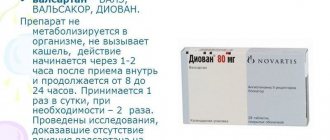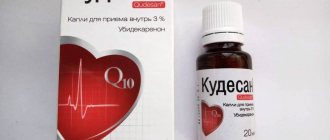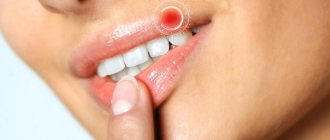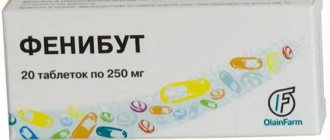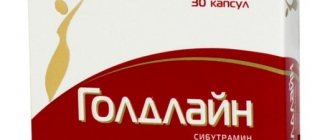Instructions for use
Doctors recommend taking the medicine in the morning after a light breakfast.
The tablet is placed on the tongue and washed down with 120 ml of water. The initial dose is 5 mg; depending on the severity of the underlying disease and the presence of concomitant pathologies, the dose can be adjusted. For chronic heart failure and as maintenance therapy, Amlodipine 2.5 mg is prescribed. During the first 2–3 weeks, dynamic blood pressure monitoring is required. If the effect is insignificant, the doctor increases the dosage to 10 mg.
Special instructions:
Be careful when driving vehicles and operating other mechanisms that require concentration and quick reaction. May cause short-term dizziness. Careful monitoring of laboratory parameters in people with renal and hepatic insufficiency. It is undesirable to use Amlodipine during pregnancy - it is fetotoxic
However, doctors may prescribe it if the benefits of therapy outweigh the acceptable risk to the fetus. It is recommended to stop breastfeeding while using the drug. A woman can pump to maintain lactation. Use with caution in persons with aortic stenosis. Use in pediatric practice is prohibited due to lack of evidence base.
Instructions for use and interaction with other products
The dosage is calculated as follows:
- The standard instructions indicate that Amlodipine is taken orally once a day. The initial dose should not exceed 5 mg. Over the course of 10-14 days, if necessary, it can increase to 10 mg.
Patients diagnosed with arterial hypertension are recommended to take 2.5 mg as a maintenance dose. The same amount of the drug is prescribed to people with low body weight, short stature or old age.- In the presence of heart failure (chronic), the initial dose is 2.5 mg. If the patient tolerates the drug well, the dosage is increased to 10 mg.
- For angina pectoris and arterial hypertension, Normodipine is taken 5 mg once a day. The maximum amount is 10 mg. At the end of the course of therapy, doses are gradually reduced. This will help avoid withdrawal symptoms.
- Dosage adjustments should be made by a specialist. Self-medication can lead to a sharp decrease in blood pressure and a deterioration in general condition.
The main component included in these dosage forms can lead to various reactions when used simultaneously with other drugs. Features of complex use of Normodipin with:
The interaction of Amlodipine with various medications is characterized by similar features, since both drugs are based on the same component. Experts consider it safe to combine the substance with classic NSAIDs, antianaginal medications, as well as hypoglycemic and antibacterial medications.
The attending physician must be aware of what drugs the patient is taking. This information will help you choose the most effective treatment method and not cause harm to the body.
Indications for use
The product has proven itself well and received positive feedback from patients. Patients who want to know in what cases they need to take this medicine should study the instructions for use of Amlodipine-Pran.
Correct use will allow you to get the maximum effect and avoid side effects. Indications for use of Amlodipine-Pran are as follows:
- angina pectoris (stable, unstable);
- symptomatic or persistent hypertension (arterial hypertension);
- variant Prinzmetal angina;
- ischemic heart disease.
You need to know that the medication acts gradually and is prolonged, that is, the effect will not appear immediately after administration, but several hours later. Therefore, for cases where emergency care is required, for example, during a hypertensive crisis, the drug is not suitable.
Video on the topic
Instructions for using the drug Amlodipine in the video:
According to hypertensive patients, Amlodipine is the best remedy for normalizing blood pressure. It has gained popularity among therapists and their patients due to its convenient administration - once a day, prolonged action - blood pressure does not increase for 20-24 hours, that is, until the next dose of the drug.
The information on the MyMedNews.ru website is for reference and general information, collected from publicly available sources and cannot serve as a basis for making a decision on the use of medications in the course of treatment.
MyMedNews.ru
And we also have
The drug Andipal - what does it help with and at what pressure can it be taken?
Features of application:
During treatment, monitoring of body weight and sodium intake is necessary. You should maintain dental hygiene and visit the dentist frequently. When increasing the dose, careful monitoring of elderly patients is necessary.
The drug does not affect plasma concentrations of K+, glucose, triglycerides, total cholesterol, LDL, uric acid, creatinine and urea nitrogen.
Precautionary measures. Caution must be exercised when prescribing to patients with hepatic and/or renal failure, chronic heart failure.
At the beginning of treatment, dizziness and drowsiness are possible; in this case, special precautions must be taken when driving a car and when working with machinery.
AMLODIPINE-PRANA
Interaction
Amlodipine can be safely used for the treatment of hypertension together with thiazide diuretics, alpha-blockers, beta-blockers or ACE inhibitors.
In patients with stable angina, the drug can be combined with other antianginal agents, for example, long- or short-acting nitrates, beta-blockers. Amlodipine can be used concomitantly with non-steroidal anti-inflammatory drugs (NSAIDs) (especially indomethacin), antibacterial agents and oral hypoglycemic agents.
It is possible to enhance the antianginal and hypotensive effect of BMCC when used together with thiazide and loop diuretics, verapamil, ACE inhibitors, beta-blockers and nitrates, as well as enhance their hypotensive effect when used together with alpha 1-blockers, antipsychotics.
Although negative inotropic effects have not generally been observed in amlodipine studies, some CBMCs may enhance the negative inotropic effects of antiarrhythmics and QT prolonging agents (eg, amiodarone and quinidine).
A single dose of 100 mg of sildenafil in patients with essential hypertension does not affect the pharmacokinetic parameters of amlodipine.
Repeated use of amlodipine at a dose of 10 mg and atorvastatin at a dose of 80 mg is not accompanied by significant changes in the pharmacokinetics of atorvastatin.
Ethanol (drinks containing alcohol): amlodipine with single and repeated use in a dose of 10 mg does not affect the pharmacokinetics of ethanol. Antiviral agents (ritonavir) increase plasma concentrations of BMCC, incl. amlodipine.
Neuroleptics and isoflurane - enhance the hypotensive effect of dihydropyridine derivatives.
Calcium supplements may reduce the effect of BMCC.
When amlodipine is used together with lithium preparations, it is possible to increase the manifestation of neurotoxicity (nausea, vomiting, diarrhea, ataxia, tremor, tinnitus).
Amlodipine does not change the pharmacokinetics of cyclosporine.
Does not affect the serum concentration of digoxin and its renal clearance.
Does not have a significant effect on the effect of warfarin (prothrombin time).
Cimetidine does not affect the pharmacokinetics of amlodipine.
In in vitro studies, amlodipine does not affect the binding of digoxin, phenytoin, warfarin and indomethacin to blood proteins.
Grapefruit juice: simultaneous single administration of 240 mg of grapefruit juice and 10 mg of amlodipine orally is not accompanied by a significant change in the pharmacokinetics of amlodipine.
Interaction with other drugs
The combined use of Amlodipine-Pran with other drugs may lead to an increase or decrease in the effect, increased toxicity, etc. The instructions indicate the following possible reactions:
- combining the drug with other antihypertensive medications is generally safe, but if the dosage is violated, it can cause an increase in the effect of Amlodipine-Pran, a significant decrease in blood pressure, and provoke hypotension;
- lithium preparations can lead to neurotoxic manifestations (tremor, vomiting, diarrhea, ringing sensation in the ears);
- products containing estrogens, as well as non-steroidal anti-inflammatory drugs, reduce the ability of the drug to reduce blood pressure, as they retain sodium ions and fluid in the body;
- parallel use with Quinidine enhances the antihypertensive effect;
- combined use with Orlistat tablets can cause an increase in blood pressure;
- medications that reduce the activity of liver enzymes can enhance the toxic properties of Amlodipine-Pran.
Any combination of medications is possible only after the doctor’s approval.
Amlodipine-Prana tablets 5 mg No. 30
Interaction
Amlodipine can be safely used for the treatment of hypertension together with thiazide diuretics, alpha-blockers, beta-blockers or ACE inhibitors.
In patients with stable angina, the drug can be combined with other antianginal agents, for example, long- or short-acting nitrates, beta-blockers. Amlodipine can be used concomitantly with non-steroidal anti-inflammatory drugs (NSAIDs) (especially indomethacin), antibacterial agents and oral hypoglycemic agents.
It is possible to enhance the antianginal and hypotensive effect of BMCC when used together with thiazide and loop diuretics, verapamil, ACE inhibitors, beta-blockers and nitrates, as well as enhance their hypotensive effect when used together with alpha 1-blockers, antipsychotics.
Although negative inotropic effects have not generally been observed in amlodipine studies, some CBMCs may enhance the negative inotropic effects of antiarrhythmics and QT prolonging agents (eg, amiodarone and quinidine).
A single dose of 100 mg of sildenafil in patients with essential hypertension does not affect the pharmacokinetic parameters of amlodipine.
Repeated use of amlodipine at a dose of 10 mg and atorvastatin at a dose of 80 mg is not accompanied by significant changes in the pharmacokinetics of atorvastatin.
Ethanol (drinks containing alcohol): amlodipine with single and repeated use in a dose of 10 mg does not affect the pharmacokinetics of ethanol. Antiviral agents (ritonavir) increase plasma concentrations of BMCC, incl. amlodipine.
Neuroleptics and isoflurane - enhance the hypotensive effect of dihydropyridine derivatives.
Calcium supplements may reduce the effect of BMCC.
When amlodipine is used together with lithium preparations, it is possible to increase the manifestation of neurotoxicity (nausea, vomiting, diarrhea, ataxia, tremor, tinnitus).
Amlodipine does not change the pharmacokinetics of cyclosporine.
Does not affect the serum concentration of digoxin and its renal clearance.
Does not have a significant effect on the effect of warfarin (prothrombin time).
Cimetidine does not affect the pharmacokinetics of amlodipine.
In in vitro studies, amlodipine does not affect the binding of digoxin, phenytoin, warfarin and indomethacin to blood proteins.
Grapefruit juice: simultaneous single administration of 240 mg of grapefruit juice and 10 mg of amlodipine orally is not accompanied by a significant change in the pharmacokinetics of amlodipine.
Analogs
Analogues of Amlodipine Prana are: Amlorus, Amlotop, Kalchek, Norvasc, Tenox and many other drugs containing amlodipine.
To evaluate the advantages and disadvantages, it is worth considering some of them. Amlorus belongs to the subgroup of dihydropyridines, a group of calcium channel blockers. The main substance is amlodipine, available in tablets of 2.5 mg, 5 mg and 10 mg. Effectively reduces blood pressure and fights ischemic areas of the myocardium.
Indicated for hypertension of II-III degree, angina pain, chronic heart failure in the stage of decompensation. The initial dose is 5 mg, then the dose is adjusted. The agent is not recommended for:
pregnancy; acquired heart defects; in the acute period of MI; with caution in elderly people.
Norvasc - the active ingredient is amlodipine, available in 5 mg and 10 mg. Inhibits transmembrane calcium transfer into cardiomyocytes and vascular smooth muscle cells, which provides antihypertensive and anti-ischemic effects.
It is well tolerated by patients; dizziness, malaise, gynecomastia in men, dyspeptic changes, and swelling of the lower extremities are rarely observed. However, the cost of Norvasc is quite high.
Side effects
In some cases, various side effects occur, the appearance of which is determined by the individual reaction of the human body to the administration of this medication:
- Formation of peripheral edema in the legs.
- Audible heartbeat.
- A sharp decrease in blood pressure.
- Development of orthostatic hypotension.
- Signs of vasculitis.
- Heart failure.
- Development of ventricular tachycardia.
- Symptoms of bradycardia.
- Pronounced atrial fibrillation.
- Myocardial infarction attack.
- Pain in the chest area.
- Severe migraine.
- Prolonged headaches with dizziness.
- Increased fatigue.
- Constant sleepiness.
- General malaise.
- Fainting state.
- Paresthesia of the upper or lower extremities.
- Signs of hypoesthesia.
- Development of asthenia.
- Tremor.
- Manifestation of peripheral neuropathy.
Chronic insomnia.
- Sudden mood swings.
- Increased nervousness.
- Long-term depression.
- Anxiety.
- Seizures.
- The occurrence of ataxia.
- Temporary manifestation of amnesia.
- Attacks of nausea.
- Quite severe vomiting.
- Violation of bowel movements.
- Abdominal pain occurs.
- Accelerated anorexia.
- Increased dryness of the oral mucosa.
- A sharp increase in appetite.
- Signs of gum hyperplasia.
- Pancreatitis or gastritis.
- Development of hyperbilirubinemia.
- Symptoms of jaundice.
- Increases the activity of liver transaminases.
- The appearance of leukopenia.
- Cramps of different muscle groups.
- Myalgia with arthralgia.
- Pain in the back area.
- The appearance of arthrosis.
- Signs of myasthenia.
- Severe shortness of breath.
- Symptoms of rhinitis.
- Coughing attacks.
- Severe itching.
- Formation of angioedema.
- Development of erythema multiforme.
- Symptoms of urticaria.
- Intense baldness.
- The occurrence of ringing in the ears.
Other manifestations of adverse reactions may also occur.
INTERACTION WITH OTHER MEDICINES
It can be expected that inhibitors of microsomal oxidation will increase the concentration of amlodipine in plasma, increasing the risk of side effects, and inducers of microsomal liver enzymes will decrease it.
Cimetidine: with simultaneous use of amlodipine with cimetidine, the pharmacokinetics of amlodipine does not change.
Grapefruit juice: simultaneous single administration of 240 ml of grapefruit juice and 10 mg of amlodipine orally is not accompanied by a significant change in the pharmacokinetics of amlodipine.
Unlike other BMCCs, no clinically significant interaction with Norvasc (III generation BMCCs) was detected when used in combination with non-steroidal anti-inflammatory drugs (NSAIDs), especially indomethacin.
It is possible to enhance the antianginal and hypotensive effect of BMCC when used together with thiazide and loop diuretics, verapamil, ACE inhibitors, beta-blockers and nitrates, as well as increase their hypotensive effect when used together with alpha1-blockers, antipsychotics. Although no negative inotropic effect was generally observed in studies of Norvasc, some BMCCs may enhance the negative inotropic effect of antiarrhythmic drugs that cause QT prolongation (for example, amiodarone and quinidine).
When BMCC is used together with lithium preparations (no data are available for Norvasc), their neurotoxicity (nausea, vomiting, diarrhea, ataxia, tremor, tinnitus) may increase.
Amlodipine does not affect the degree of plasma protein binding of digoxin, phenigoin, warfarin and indomethacin in vitro.
Aluminum/Magnesium containing antacids: their single dose does not have a significant effect on the pharmacokinetics of amlodipine.
Sildenafil (Viagra): a single dose of 100 mg of sildenafil in patients with essential hypertension does not affect the pharmacokinetic parameters of amlodipine.
Atorvastatin: repeated use of amlodipine at a dose of 10 mg and atorvastatin at a dose of 80 mg is not accompanied by significant changes in the pharmacokinetics of atorvastatin.
Digoxin: Serum levels and renal clearance of digoxin are not affected when amlodipine is coadministered with digoxin in healthy volunteers.
Ethanol (alcohol-containing drinks): with single and repeated use in a dose of 10 mg, amlodipine does not have a significant effect on the pharmacokinetics of ethanol.
Warfarin: Amlodipine does not affect changes in prothrombin time caused by warfarin.
Cyclosporine: Amlodipine does not cause significant changes in the pharmacokinetics of cyclosporine.
Amlodipine-Prana
Amlodipine can be safely used for the treatment of hypertension together with thiazide diuretics, alpha-blockers, beta-blockers or ACE inhibitors. In patients with stable angina, the drug can be combined with other antianginal agents, for example, long- or short-acting nitrates, beta-blockers.
Amlodipine can be used concomitantly with non-steroidal anti-inflammatory drugs (NSAIDs) (especially indomethacin), antibacterial agents and oral hypoglycemic agents.
It is possible to enhance the antianginal and hypotensive effect of BMCC when used together with thiazide and loop diuretics, verapamil, ACE inhibitors, beta-blockers and nitrates, as well as enhance their hypotensive effect when used together with alpha 1-blockers, antipsychotics.
Although negative inotropic effects have not generally been observed in amlodipine studies, some CBMCs may enhance the negative inotropic effects of antiarrhythmics and QT prolonging agents (eg, amiodarone and quinidine).
A single dose of 100 mg of sildenafil in patients with essential hypertension does not affect the pharmacokinetic parameters of amlodipine.
Repeated use of amlodipine at a dose of 10 mg and atorvastatin at a dose of 80 mg is not accompanied by significant changes in the pharmacokinetics of atorvastatin.
Ethanol (drinks containing alcohol): amlodipine with single and repeated use in a dose of 10 mg does not affect the pharmacokinetics of ethanol. Antiviral agents (ritonavir) increase plasma concentrations of BMCC, incl. amlodipine.
Neuroleptics and isoflurane - enhance the hypotensive effect of dihydropyridine derivatives.
Calcium supplements may reduce the effect of BMCC.
When amlodipine is used together with lithium preparations, it is possible to increase the manifestation of neurotoxicity (nausea, vomiting, diarrhea, ataxia, tremor, tinnitus).
Amlodipine does not change the pharmacokinetics of cyclosporine.
Does not affect the serum concentration of digoxin and its renal clearance.
Does not have a significant effect on the effect of warfarin (prothrombin time).
Cimetidine does not affect the pharmacokinetics of amlodipine.
In in vitro studies, amlodipine does not affect the binding of digoxin, phenytoin, warfarin and indomethacin to blood proteins.
Grapefruit juice: simultaneous single administration of 240 mg of grapefruit juice and 10 mg of amlodipine orally is not accompanied by a significant change in the pharmacokinetics of amlodipine.
CONTRAINDICATIONS
Hypersensitivity to amlodipine and other dihydropyridipe derivatives, as well as to the excipients included in the drug.
Severe hypotension
Prescribed with CAUTION to patients with liver failure, CHF of non-ischemic etiology of class III-IV, aortic stenosis, acute myocardial infarction (and within 1 month after it), under the age of 18 years (efficacy and safety have not been precisely established)
As with the appointment of other BMCCs, caution must be exercised when taking amlodipine in patients with sick sinus syndrome, mitral stenosis, hypertrophic obstructive cardiomyopathy, and arterial hypotension.
Amlodipine-KRKA
Amlodipine can be safely used for the treatment of arterial hypertension together with thiazide diuretics, alpha-blockers, beta-blockers or ACE inhibitors. In patients with stable angina, amlodipine can be combined with other antianginal agents, for example, long- or short-acting nitrates, beta-blockers.
Unlike other BMCCs, no clinically significant interaction of amlodipine was found when used concomitantly with non-steroidal anti-inflammatory drugs (NSAIDs), including indomethacin.
It is possible to enhance the antianginal and antihypertensive effects of BMCC when used simultaneously with thiazide and loop diuretics, ACE inhibitors, beta-blockers and nitrates
, as well as enhancing their antihypertensive effect when used simultaneously with alpha1-blockers and antipsychotics.
In laboratory animals, cases of ventricular fibrillation with collapse and death have been reported during the use of verapamil
and intravenous administration of dantrolene, accompanied by hyperkalemia. Due to the risk of developed hyperkalemia, the simultaneous use of BMCC, including amlodipine, and dantrolene should be avoided in patients susceptible to malignant hyperthermia, as well as in the treatment of malignant hyperthermia.
Although negative inotropic effects have generally not been observed in amlodipine studies, some CBMCs may enhance the negative inotropic effects of antiarrhythmic drugs that cause QT prolongation (eg, amiodarone and quinidine).
Amlodipine can also be safely used concomitantly with antibiotics and oral hypoglycemic agents.
Single dose of 100 mg sildenafil
in patients with essential hypertension does not affect the pharmacokinetic parameters of amlodipine.
Repeated use of amlodipine 10 mg and atorvastatin
at a dose of 80 mg is not accompanied by significant changes in the pharmacokinetics of atorvastatin.
Simvastatin
: Simultaneous repeated use of amlodipine at a dose of 10 mg and simvastatin at a dose of 80 mg leads to an increase in simvastatin exposure by 77%. In such cases, the dose of simvastatin should be limited to 20 mg.
Ethanol (drinks
containing alcohol
): amlodipine with single and repeated use in a dose of K) mg does not affect the pharmacokinetics of ethanol.
Antivirals (ritonavir):
increase in plasma concentrations of BMCC. including amlodipine.
Neuroleptics and isoflurane
enhancing the antihypertensive effect of dihydropyridine derivatives.
Calcium preparations:
may reduce the effect of BMCC.
With simultaneous use of BMCC with lithium preparations
(no data available for amlodipine) their neurotoxicity may increase (nausea, vomiting, diarrhea, ataxia, tremor, tinnitus).
Studies of concomitant use of amlodipine and cyclosporine
in healthy volunteers and all groups of patients, with the exception of patients after kidney transplantation, were not carried out. Various studies of the interaction of amlodipine with cyclosporine in patients after transplantation of the night show that the use of this combination may either not lead to any effect or increase the minimum concentration of cyclosporine to varying degrees, up to 40%. These data should be taken into account and cyclosporine concentrations should be monitored in this group of patients when cyclosporine and amlodipine are co-administered.
Does not affect serum concentrations of digoxin
and its renal clearance.
Does not significantly affect the action of warfarin
(prothrombin time indicator).
Cimetidine
: does not affect the pharmacokinetics of amlodipine.
in vitro studies
of digoxin, phenytoin, warfarin and indomethacin
to plasma proteins Grapefruit juice:
A simultaneous single dose of 240 mg of grapefruit juice and 10 mg of amlodipine orally is not accompanied by a significant change in the pharmacokinetics of amlodipine. However, it is not recommended to use grapefruit juice and amlodipine at the same time, since genetic polymorphism of the CYP3A4 isoenzyme may increase the bioavailability of amlodipine and, as a result, enhance the antihypertensive effect.
Aluminum or magnesium containing antacids:
their single dose does not have a significant effect on the pharmacokinetics of amlodipine.
CYP3A4 isoenzyme inhibitors:
with simultaneous use of diltiazem at a dose of 180 mg and amlodipine at a dose of 5 mg in patients from 69 to 87 years of age with arterial hypertension, an increase in systemic exposure of amlodipine by 57% was observed.
Concomitant use of amlodipine and erythromycin
in healthy volunteers (18 to 43 years of age) does not lead to significant changes in amlodipine exposure (increase in area under the concentration-time curve (AUC) by 22%). Although the clinical significance of these effects is unclear, they may be more pronounced in older patients.
Potent CYP3A4 inhibitors (eg, ketoconazole, itraconazole)
may lead to an increase in plasma concentrations of amlodipine to a greater extent than diltiazem. Amlodipine and inhibitors of the CYP3A4 isoenzyme should be used with caution.
Clarithromycin
: Patients taking clarithromycin (CYP3A4 isoenzyme inhibitor) and amlodipine at the same time have an increased risk of decreased blood pressure. Patients taking this combination are advised to be under close medical supervision.
Inducers of the CYP3A4 isoenzyme:
with simultaneous use of inducers of the CYP3A4 isoenzyme, the concentration of amlodipine in the blood plasma may change. Therefore, it is necessary to monitor blood pressure and adjust the dose of medications taken both during and after their simultaneous use (including rifampicin, St. John's wort preparations).
Tacrolimus
: When used simultaneously with amlodipine, there is a risk of increasing the concentration of tacrolimus in the blood plasma. To avoid toxicity of tacrolimus when used concomitantly with amlodipine, the concentration of tacrolimus in the blood plasma of patients should be monitored and the dose of tacrolimus should be adjusted if necessary.
Mammalian target of rapamycin (mTOR) inhibitors)
: mTOR inhibitors such as sirolimus, temsirolimus and everolimus are substrates of the CYP3A isoenzyme. Amlodipine is a weak inhibitor of the CYP3A isoenzyme. When used concomitantly with mTOR inhibitors, amlodipine may increase their exposure.
Amlodipine-Prana, 90 pcs., 5 mg, tablets
Amlodipine can be safely used for the treatment of hypertension together with thiazide diuretics, alpha-blockers, beta-blockers or ACE inhibitors. In patients with stable angina, the drug can be combined with other antianginal agents, for example, long- or short-acting nitrates, beta-blockers.
Amlodipine can be used concomitantly with non-steroidal anti-inflammatory drugs (NSAIDs) (especially indomethacin), antibacterial agents and oral hypoglycemic agents.
It is possible to enhance the antianginal and hypotensive effect of BMCC when used together with thiazide and loop diuretics, verapamil, ACE inhibitors, beta-blockers and nitrates, as well as enhance their hypotensive effect when used together with alpha 1-blockers, antipsychotics.
Although negative inotropic effects have not generally been observed in amlodipine studies, some CBMCs may enhance the negative inotropic effects of antiarrhythmics and QT prolonging agents (eg, amiodarone and quinidine).
A single dose of 100 mg of sildenafil in patients with essential hypertension does not affect the pharmacokinetic parameters of amlodipine.
Repeated use of amlodipine at a dose of 10 mg and atorvastatin at a dose of 80 mg is not accompanied by significant changes in the pharmacokinetics of atorvastatin.
Ethanol (drinks containing alcohol): amlodipine with single and repeated use in a dose of 10 mg does not affect the pharmacokinetics of ethanol. Antiviral agents (ritonavir) increase plasma concentrations of BMCC, incl. amlodipine.
Neuroleptics and isoflurane - enhance the hypotensive effect of dihydropyridine derivatives.
Calcium supplements may reduce the effect of BMCC.
When amlodipine is used together with lithium preparations, it is possible to increase the manifestation of neurotoxicity (nausea, vomiting, diarrhea, ataxia, tremor, tinnitus).
Amlodipine does not change the pharmacokinetics of cyclosporine.
Does not affect the serum concentration of digoxin and its renal clearance.
Does not have a significant effect on the effect of warfarin (prothrombin time).
Cimetidine does not affect the pharmacokinetics of amlodipine.
In in vitro studies, amlodipine does not affect the binding of digoxin, phenytoin, warfarin and indomethacin to blood proteins.
Grapefruit juice: simultaneous single administration of 240 mg of grapefruit juice and 10 mg of amlodipine orally is not accompanied by a significant change in the pharmacokinetics of amlodipine.

